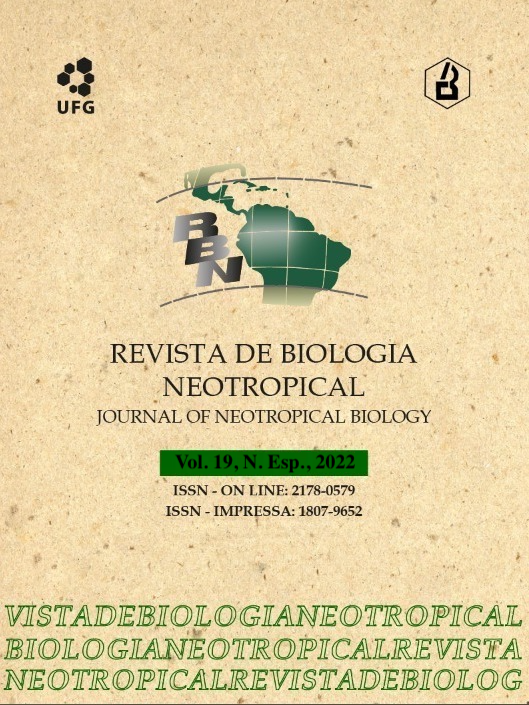Skin healing in the terrestrial toad Melanophryniscus montevidensis (Philippi, 1902): an experimental approach
DOI:
https://doi.org/10.5216/rbn.v19iesp.73885Keywords:
amphibians, healing, histology, anesthesia, MelanophryniscusAbstract
We studied in this work the skin healing process in the terrestrial toad Melanophryniscus montevidensis. Wild specimens were acclimated in the laboratory, and an experimental skin wound of 1.5 mm diameter was made in the dorsum region under clove oil anesthesia, leaving the dermis exposed. Monitoring of the healing process by conventional histology was made up to 129 days. The epidermal protection of the wound was recovered after two days, and apparently, a complete recovery of dermal glandular structures was evident after 37 days. This feature includes the serous glands that play a relevant role in the defensive strategy of this species. No complications were recorded from the anesthetic procedure, not previously assessed in Melanophryniscus.
Downloads
References
AFIP. Armed Forces Institute of Pathology. 1949. Routine staining procedures. pp. 32-46. In: Manual of histologic staining methods. 2rd ed. New York, McGraw-Hill.
Altig, R. 1980. A convenient killing agent for amphibians, Herp. Rev. 11(2): 35.
Brunetti, A., G. Hermida, M. Lurman & J. Faivovich. 2016. Odorous secretions in anurans: morphological and functional assessment of serous glands as a source of volatile compounds in the skin of the treefrog Hypsiboas pulchellus (Amphibia: Anura: Hylidae). J. Anat. 228(3): 430-442.
Delfino, G., R. Brizzi, R. Kracke-Berndorff & B. Alvarez. 1998. Serous gland Dimorphism in the Skin of Melanophryniscus stelzneri (Anura: Bufonidae). J. Morphol 237(1): 19-32.
Duellman, W. E. & L. Trueb. 1986. Biology of Amphibians. Baltimore, London, The Johns Hopkins University Press, 670 p.
Ferraro, D. R., P. E. Topa & G. N. Hermida. 2013. Lumbar glands in the frog genera Pleurodema and Somuncuria (Anura: Leiuperidae): histological and histochemical perspectives. Acta Zool. 94(1): 44–57.
Fox, H. 1994. The structure of the integument. pp. 1-32. In: Heatwole, H. & G. T. Barthalamus (Eds.). Amphibian Biology, Vol. 1, The Integument. Sidney, Surrey Beatty & Sons.
Frost, D. 2022. Amphibian species of the world 6.0. An on-line reference. Available in: <https://amphibiansoftheworld.amnh.org/>. Accessed 21 Aug. 2022.
Hantak, M. M., T. Grant, S. Reinsch, D. Mcginnity, M. Loring, N. Toyooka & R. A. Saporito. 2013. Dietary alkaloid sequestration in a poison fog: an experimental test of alkaloid uptake in Melanophryniscus stelzneri (Bufonidae). J. Chem. Ecol. 39(11-12): 1400-1406.
Hernández, S., C. Sernia & A. Bradley. 2012. The effect of three anaesthetic protocols on the stress response in cane toads (Rhinella marina). Vet. Anaest. Analg. 39(6): 584-590.
Kawasumi, A., Sagawa, N., Hayashi, S., Yokoyama, H. & K. Tamura. 2013. Wound healing in mammals and amphibians: toward limb regeneration in mammals. Curr. Top. Microbiol. Immunol. 367: 33-49.
Kolenc, F. 1988. Anuros del género Melanophryniscus en la República Oriental del Uruguay. Aquamar 30: 16-21.
Leévesque, M., É. Villiard & S. Roy. 2010. Skin wound healing in axolotls: a scarless process. J. Exp. Zool. B (Mol. Devel. Evol.). 314(8): 684-697.
Luna, M. C., R. W. McDiarmid & J. Faivovich. 2018. From erotic excrescences to pheromone shots: structure and diversity of nuptial pads in anurans. Biol. J. Linn. Soc. 124(3): 403–446.
Mangione, S. & M. Alcaide. 1994. Histología de piel del parche pélvico en referencia a piel dorsal y ventral, en Menaophryniscus rubiventris subcondolor (Anura, Bufonidae). Bol. Asoc. Herp. Arg. 10(1): 28-30.
McClanahan, L. L. Jr., V. H. Shoemaker & R. Ruibal. 1976. Structure and function of the cocoon of a ceratophryd frog. Copeia. 1976(1): 179-185.
Mitchell, M. A. 2009. Anesthetic considerations for amphibians. J. Exot. Pet Med. 18(1): 40-49.
Naya, D. E., J. A. Langone & R. O. de Sá. 2004. Histological features of the frontal tumefaction in Melanophryniscus (Amphibia: Anura: Bufonidae). Rev. Chil. Hist. Nat. 77(4): 593-598.
Otuska-Yamaguchi, R., A. Kawasumi-Kita, N. Kudo, Y. Izutsu, K. Tamura & H. Yokoyama. 2017. Cells from subcutaneous tissues contribute to scarless skin regeneration in Xenopus laevis froglets. Dev. Dyn. 246(8): 585-597.
Sadeghipour, A. & P. Babaheidarian. 2019. Making formalin-fixed, paraffin embedded blocks. pp. 253-268. In: Yong, W. H. (Ed.). Biobanking: Methods and Protocols, Methods in Molecular Biology. New York, Humana Press.
Tedros, M., F. Kolenc & C. Borteiro. 2001. Melanophryniscus montevidensis. (Phillipi, 1902) (Anura, Bufonidae). Cuad. Herpetol. 15(2): 143.
Toledo, L. F. & C. F. B. Haddad. 2009. Colors and some morphological traits as defensive mechanisms in anurans. Int. J. Zool. 2009(1-4): 1-12.
Yannas, I. V., J. Colt & Y. C. Wai. 1996. Wound contraction and scar synthesis during development of the amphibian Rana catesbeiana. Wound Repair Regen. 4(1): 29-39.
Yokoyama, H., T. Maruoka & A. Aruga. 2011. Prx-1 Expression in Xenopus laevis scarless skin-wound healing and its resemblance to epimorphic regeneration. J. Inv. Dermatol. 131(12): 2477-2485.
Yokoyama, H., Kudo, N., Todate, M., Shimada, Y., Susuki, M. & K. Tamura. 2018. Skin regeneration of amphibians: A novel model for skin regeneration as adults. Develop. Growth Differ. 00: 1-10.
Downloads
Published
How to Cite
Issue
Section
License
Copyright (c) 2023 Revista de Biologia Neotropical / Journal of Neotropical Biology

This work is licensed under a Creative Commons Attribution-NonCommercial 4.0 International License.
The expontaneos submmition of the manuscript automaticaly implies in the cession of all patrimonial rights for the Journal of Neotropical Bilogy (RBN) after publication. The autor allow the right of first publication of the article to the RBN, under Creative Commons Attribution 4.0 (CC BY-NC 4.0) Licence.
There are garanties for the authors to the authorial and moral rights, for each one of the articles published by RBN, with permissions:
1. The use of article and contents for the education and researches.
2. The use of the article and their contents, linking to the Article on the web site of the RBN, allowing the divulgation on:
- institutional closed web (intranet).
- open access repositories.
3. Preparation and divulgation of the other publication derived from the article and its content, if there is citation of the original publication by RBN.
4. Make printed copies in small quatinties for personal use.

















